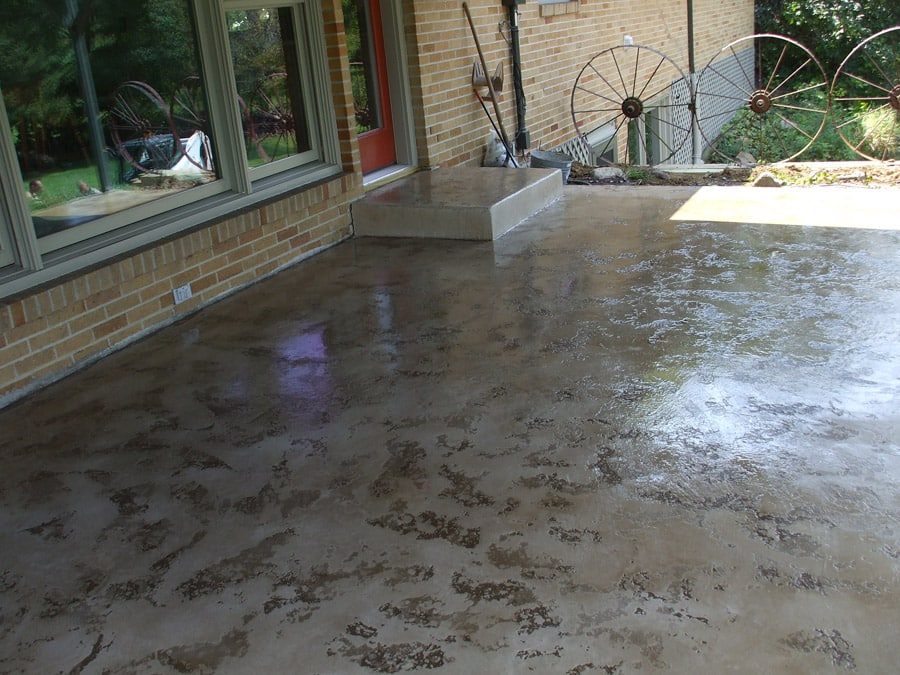Concrete is a sturdy material that can last for years if properly taken care of. It is also one of the most popular surfaces to stain because it can be done in various ways, with varying degrees of difficulty and contrast.
When you decide how to make your concrete look even better than before, there are some common mistakes to avoid and tips to get right.
What is stained concrete?
Stained concrete is the process of adding color to concrete. The stain can be a dye, which will add permanent color, or a sealant that will add temporary color. There are also acid stains and water-based concrete stains react chemically to the surface of the concrete and leave behind a translucent finish.
What stain do you choose?
There are two options when choosing stained concrete floors: dyes and sealers.
Dye stains can give the most dramatic effects but require prepping for days to weeks beforehand and applying slow-curing coats on concrete floors that allow each layer to dry.
Concrete dyes are permanent, so they should be applied only on residential and commercial properties where the color won’t matter or can easily be removed if it doesn’t work out as planned. Dyes tend to fade and change slowly, so they are ideal for concrete patios, pool decks, and other porous cementitious surfaces that will stay mostly exposed to the sun.
You can use dye stains on various decorative concrete surfaces, including stamped or polished concrete (crushed rock), more absorbent. Because dyes soak in rather than sitting atop the surface as sealers do, it’s essential to check the absorbency of the concrete floor before you start. If it’s not absorbent enough, the concrete dye won’t penetrate, and you’ll be left with a blotchy finish.
Sealers are less permanent than dyes and can be applied in one or two coats, but they require more maintenance because they need to be reapplied every few years.
Sealers are an excellent choice for concrete driveways and floors because they protect the surface from chemicals and water, so you don’t have to worry about rust or pitting.
You can apply a sealer on even more absorbent surfaces such as sandstone (natural stone), but it will also impede the absorption of any sealer or stain that you apply afterward. Sealers are great for patios, floors, and countertops because they will protect the concrete from damage while adding color to those flat surfaces.
Is concrete epoxy a type of concrete stain?
No, epoxy is not a type of concrete stain. Epoxy is a decorative concrete coating applied to concrete floors to provide a challenging, glossy finish. You can use it on your pool deck, garage floors, basement floors, and other areas where you want a durable surface.
Epoxy comes in two parts: the resin and the hardener.
- The resin is a sticky substance spread onto the surface and can take a few hours to overnight to dry.
- The hardener, which should be mixed with the resin before application, will need 15 minutes to set up correctly.
You’ll want to wear gloves when working with epoxy because it’s difficult (if not impossible) to remove once it sets. If you get the epoxy on your skin, take a warm shower to remove any residue before washing as usual.
Once applied, the surface will be smooth and glossy for up to three years if properly maintained with an automotive wax or coating product such as Armor All ®. It’s essential not to use motor oil or petroleum-based products to damage the epoxy finish.
Concrete staining or floor epoxy?
The flooring options depending on the type of concrete you have and your goals.
Epoxy is ideal for Dallas TX garage floors, basements, or other areas where a glossy finish will make cleaning easier. It’s also great for covering up stains caused by oil leaks or rust from tools. If you’re looking to turn an existing old concrete floor into something shiny and new-looking, epoxy is the way to go.
Concrete stains are ideal for adding color and personality to your concrete outdoor surfaces. They come in various colors and can be used on driveways to countertops. If you’re looking to add some life to an otherwise flat concrete slab, concrete stains are the way to go.
You can use epoxy stains on absorbent surfaces like natural stone or stamped concrete, but it’s essential to ensure that the surface is porous enough before starting. If it’s not, the dye or sealer may not penetrate the surface properly, and you’ll be left with a blotchy finish.
Make sure to read the manufacturer’s instructions for concrete stain or epoxy before you apply them to your surface.
The top concrete stain mistakes to avoid
These are the things you need to avoid when staining concrete floors on your Fort Worth property.
Minimal surface preparation: This is one of the most common mistakes people make when installing stained concrete. The surface needs to be clean and free of any dirt, dust, or oils before you start staining. If you don’t do surface preparation correctly, the stain will not adhere well and chip off over time.
Preparing the surface too soon: Your Fort Worth residential or commercial flooring needs to be completely dry before the staining process. If there’s moisture between the cracks and it doesn’t evaporate on its own, you could end up with some severe problems in your new finish.
Applying a sealer that isn’t meant for concrete: There are many different sealers on the market, and not all are meant for concrete. Using a sealer that isn’t specifically designed for the concrete surface can cause the stain to peel or chip off over time.
Applying too much stain: It is another common mistake people make when going for stained concrete. You only need to use a thin coat of stain, and you don’t want it to be too heavy. If you apply too much stain, it will take a long time to dry and could end up looking streaky or uneven.
Not waiting long enough between coats: Another thing to remember when going for stained concrete is to wait long enough between coats. If you don’t wait long enough, the first coat won’t be fully dry before you apply the next one, and the colored concrete will end up looking streaky.
Not using a primer: Many people don’t think they need to use a primer for stained concrete, but this is a crucial step. The primer will help the stain adhere to the concrete flooring, giving you a more even finish.
Not using a sealer: If you don’t use a sealer after staining concrete, the finish will eventually start to fade and chip away. A good sealer will protect your new concrete finish and make it last a lot longer.
Not using the right tools: Doing any staining project is a simple process when you have the right equipment to do it with. Make sure that your paint roller covers are correctly sized for concrete, or they won’t work well at all. Using a brush instead of a roller can also cause uneven lines and streaks.
Not using the right paint for your project: You also need to think about what type of paint to use when staining concrete. Many different options are available, but not all colors will work well on this surface. Ensure that your finish is meant for outdoor projects before applying it to concrete.
These are some of the most common mistakes Fort Worth people make when staining concrete. You can ensure a successful project and a beautifully finished surface by avoiding these mistakes.
How to correct these concrete staining mistakes?
The best way to correct a concrete staining mistake is by sanding the stain and reapplying it. If this method doesn’t work, you can use an acid solution (i.e., muriatic) or paint stripper to remove old stains from your pavement; however, these solutions are not as effective as sanding out the stain.
If your DIY job still doesn’t work out, you’ll need to hire a professional Fort Worth concrete staining contractor. If the stain was misapplied and it’s too late now, save yourself some time and money by hiring an experienced company right away.
Professional Dallas Fort Worth staining companies have enough experience and knowledge to turn your concrete into a spectacular work of art. They will choose the best stain for your particular project, use high-quality tools and materials, apply the product correctly to get an even color throughout, seal it properly with no residue or sanding marks left behind.
Professional concrete staining companies charge more than DIY methods, but it’s worth the investment. You will be 100% satisfied with the concrete space outcome, and it will save you a lot of time and money in the long run.
Concrete staining is a beautiful way to enhance your home or business property, but only if it’s done correctly. Avoid these common mistakes and get it right the first time!

Conclusion
If you’ve been considering staining your concrete or have already started, this article will help. We hope it has given you some insights on the mistakes to avoid and what should be done correctly when considering a new stained finish for your patio, driveway, sidewalk, or other outdoor space.
Our team can provide insight into all design aspects, including color selection and application methods that utilize modern technology while preserving natural beauty.
Contact us if you need assistance from professionals who know how to get it right! DFW Stained Concrete is here to help with everything from initial consultation through installation, so give us a call today for a free quote!


